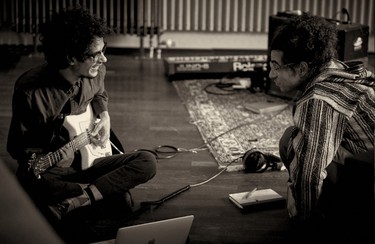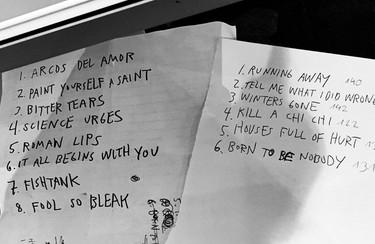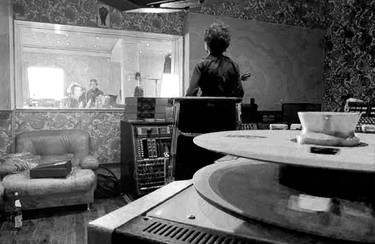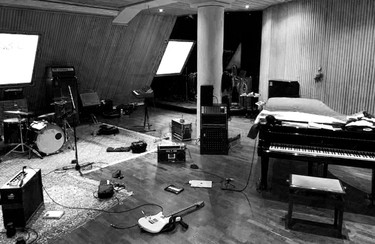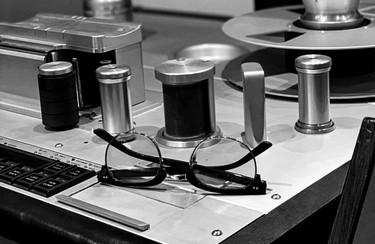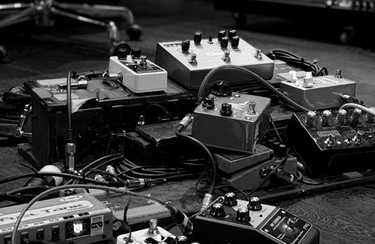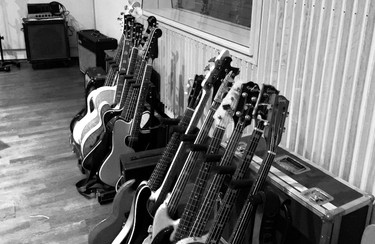The unforeseeable
Unpredictability is something that a music producer rarely delights in, but it‘s something which often has to be dealt with. Usually, the wise producer among us fear technical unpredictability most of all. The unforeseeable. Some buzzing or other noise that isn’t supposed to be there, that got missed in the heat of the moment, recorded by accident in the background, that can be heard in the final mix. Or a broken microphone, a dodgy cable, something that messes up the flow, unsettles the artist, and, in the worst-case scenario, completely destroys the mood. Experience, technical know-how and/or a skilled technician can usually get these situations under control or create a workaround for the new situation. Or even make it work, with a “it’s not a bug, it’s a feature!” vibe. In the dying notes of Peter Doherty’s “She is Far” on his Hamburg Demonstrations album, you can hear a motorcycle driving past. We had recorded a piano in the hallway of the Clouds Hill Studio, and opened the window to get a bit of atmosphere around the mic… That “mistake” immediately became a very cool feature. Riding her motorcycle into the setting sun …she was definitely far. But solving a situation like that shows the difference between a person who is only looking at the tech aspects, and a music producer. To put it simply, in a situation like this, the engineer takes care of repairing cables and de-noising signals and the producer takes care of fixing the mood or integrating the mistakes into the creative picture. Don‘t get me wrong: both jobs are important.
But no matter how good your technical expertise might be, how good you are at fixing things technically or emotionally it doesn’t help much when the musician themselves is unreliable or unpredictable. This is where you see a producer’s true quality, indeed, I would go so far as to say, whether or not someone is suited to being a music producer at all. This is where you see if it’s just a job, or if it is a calling. I don’t know why, but as a music producer, I work with a lot of musicians who are usually described as being “strong-minded”, a sweet little euphemism for ‘difficult to deal with’. But in my opinion, that is not fair to most artists. The description is too easy, too one-dimensional. A characterisation taken from the music press, which is usually only looking for the next biting headline.
Making music is not an easy thing
Now, making music is not an easy thing, if you are being serious about it. By ‘being serious’ I mean when it is about more than just having fun on stage, when it is about having a mission, a message, a critical take on the music business, and/or if you think further than the next promotional tour for the current album. Then, the focus is not so much on whether the second chorus should really “bang” or maybe not. Then, it is about the message. And the question, what this message means for the whole project, the other songs on the album, the next album, the content of the songs themselves, or the approach to music in general. That may all sound very intellectual or overly complicated, and maybe it is. But, in my opinion, it is a fact that great art can only be created this one way, and no other – we’re far from the shallow now. Great art can only rise through pain. By the way: we released an entire book about the topic, which you can get here: CHART Magazine I still remember an album production with Gallon Drunk many years ago. I had met James Johnston, the band’s singer and guitarist some years earlier, during the production of “Something Dirty”, an album by German kraut-rock legends Faust. We sat in Control Room 1 at Clouds Hill Studios, and listened to a mix of the song “The Perfect Dancer”, whose atmospheric guitar sound was created using a Ludwig Phase II synthesizer, which James played through two amplifiers which I had set up in the opposite corners of Live Room 1. The two room microphones I was using, two Royer 122v in Bluemlein setting created a truly surreal, crazy, atmospheric sound. James smiled as he heard the mix, and began talking to himself: “Oh that sounds weird!” “Yes, it does. But why? “… because we’re cool…” It’s that inner monologue that you have during the entire time of the production, when you have nothing to show to anyone yet, and even if you did, you couldn’t, because nobody would understand it yet anyway. That spirit of “Imagine a mellotron coming in here …” there’s only a very few people that get that … This process can be full of conflict and it’s the job of a producer to encourage the artist on his way. Shortly after the last tour for At The Drive-In, I rang Omar and asked if he wanted to play at the Clouds Hill Festival in December 2018. Just for fun. He said yes straight away, and we decided on the telephone that he would stay on for a couple of days after the festival to record an album. Quickly Omar put a new band together, right after our phone call. And, right there, we had the line-up for the festival, and for the recording. Audrey Paris Johnson on the drums, Virginia Garvia Alvez for vocals, and his brother, Marcel Rodríguez-Lopez on synth, bass, and programming. Omar had brought eight demos with him, which we listened to two days after the festival, at the beginning of December 2018. There were songs that had already been released on the Ipecac label a couple of years prior, but for a range of reasons, he wanted to produce them differently. I got the feeling that a lot had to do with the death of his mother a few years earlier. It wasn’t only Omar’s family life that had changed significantly, but also his view of his creative process from that time. Maybe he felt like he needed to shed the right light on a few things. On a few sounds. He explained that he had seen the drummer, Audrey, at one of her band’s gigs in LA. He liked her “kraut-y” style and really wanted to keep its roughness and the repetition of patterns. Against that, he wanted a clear focus on Virginia’s vocals. She had just got a job as the main vocalist with Circ de Solei and Omar wanted to really focus attention on her impressive voice. “Vocal-up mix” was the general strategy.“Guitars down”
It sounded as if it could be a mesmerising, surprising mix. On top of that, he also made it very clear that he was not very keen on making a guitar record. As I was not just a music producer, but also a fan, you can imagine how hard it was for me to deliver that particular wish. I think Omar is one of, if not the most remarkable guitarist of his generation. I was initially reluctant to go with “Guitars down”, but I had to admit, it gradually made more and more sense to me, and I ultimately really liked it. For Omar though, it was anything but going for the perfect solo. His goal was to create a mood, as Zack de la Rocha put it in his speech announcing The Mars Volta at the MTV Music Awards: “A band that is more interested in creating moments than creating hits”.
With Omar’s briefing in mind to let it all sound like a Krautrock-jam with non-Krautrock musicians, or something like that, Audrey and I set up the drums in the middle of Clouds Hill’s Live Room 1. The sound in Live Room 1 is a bit more “live” than in room 2. The higher ceilings and much less dampened acoustics make it feel brighter and bigger than Live Room 2 — just about right for a shimmying, echo-y drum sound. I wanted to keep it as simple as possible. Eight mics max for the drums. A raw sound. As Audrey had decided to play on our Mapex M-Series (+ Ludwig Supraphonic) I knew that those drums would be able to produce a direct and punchy sound quite naturally. So, I chose an AKG D20 for the Bassdrum and placed it about two inches away from the resonator head, and a Josephson e22 for the snare. A pair of Coles 4038 as overheads, two vintage Neumann U67s in ORTF Stereo two metres in front of the kit and the magic mic: a mono Beyerdynamic m88 approximately one metre away from the kit pointing right at the rim of the bass drum. In addition to that I used a mono highly-compressed Sennheiser MD21 mic with a weird cardioid /omni characteristic in the middle of the set between the bass drum, low tom and snare. The drum mics went straight into the Neve 8068 MKII preamps and then into the Studer A820 tape recorder. I added slight EQ from the console, mostly just adding some highs (even if you can’t really hear it on the record…ha ha), and some 60 and 100 Hz for the bass drum and set mics. For the overheads I used a pair of Pultec PEQ 1As (pushed some 100Hz and 10k) and the U67s ran through the Fairchild 670 just very subtly moving the needle. Marcel set up right in front of the drums, playing keys and bass and Omar would be in the control room, adding a scratch guitar to the recordings. When we were tracking, I turned the Beyerdynamic up very loud. It produced such a nice aggressive sound just on its own — like someone hitting a very tight cardboard box … we all liked that very much. When we wanted to hear more lows from the toms, we just slightly added in some overhead mic or the pair of U67s which also added a nice low end to the kick drum. I recorded Marcel’s synth setup straight to tape. We didn’t use an amp in the live room to avoid any spill onto the drums. In a condensed setup like this I had to be aware of that as I didn’t have any close mics to even out the spill onto room mics during mixing. After each take was complete, we re-amped Marcel’s bass, synth, and programming tracks through an Ampeg SVT and Vox AC30. We mixed the Ampeg with a Shure SM7B and the Vox with a Royer and Sennheiser 421 mostly keeping one track DI and re-amp only on one side of the stereo signal. When he played a mono synth, I mic‘d the re-amped signal from further away, to create a room sound during recording. Sometimes we put a mic in the entrance hall but left the amp in the live room with the doors open. But not enough .. after the second day Omar let me know that he was about to fly in his friend Leo from Argentina, a piano player he met during his production for Mon Laferte in South America, because he wanted him to play the piano on 6 other tracks he wanted to record. A second part of the record if you like.
